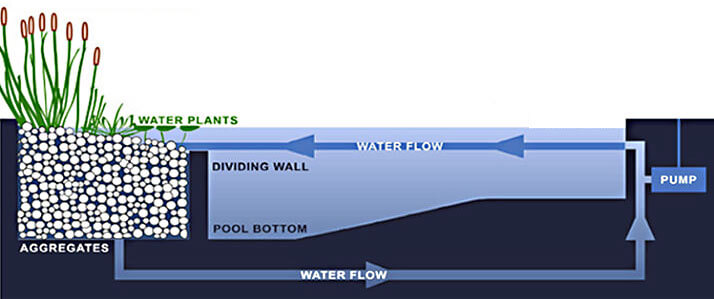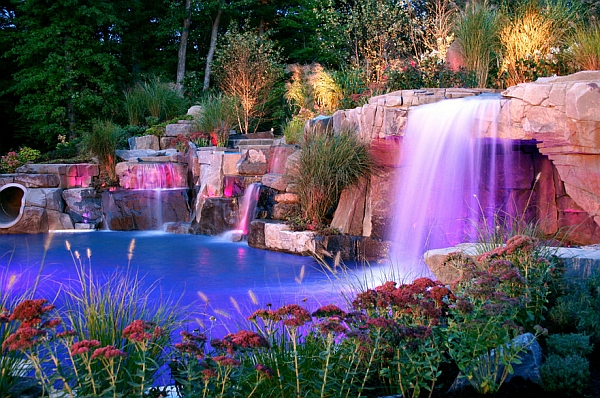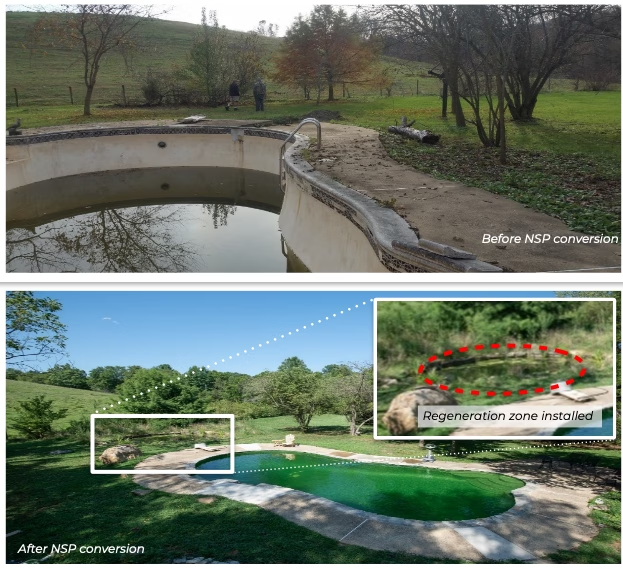Converting your traditional chlorine pool into a natural swim habitat is an intriguing project that merges personal enjoyment with environmental awareness. As you consider this transformation, you might wonder about the steps involved, the associated costs, and the benefits this change may bring. This comprehensive guide will walk you through the conversion process, helping you create a sustainable and beautiful swimming environment.
Switching from chlorine to a natural swimming pool introduces biological filtration systems that use aquatic plants to maintain water quality, fostering vibrant ecosystems. This transformation not only enhances the aesthetics of your pool but also supports ecological sustainability. Homeowners looking to make eco-friendly choices will find considerable long-term savings on maintenance and water costs. Let’s explore the steps involved in this rewarding project.
Source: BioNova Natural Pools
Transform Your Chlorine Pool into a Natural Oasis: The First Steps
Before you embark on this exciting conversion, preparation is essential. Start by draining your existing pool completely. This first step is crucial, as it allows you to make the necessary structural modifications and prepare the space for a new filtration system.
Next, remove all chlorination equipment and chemicals, as they will not be required in a natural environment. Evaluate your pool’s structure to ensure it’s sound enough to accommodate the changes needed for a natural swimming habitat. Additionally, it’s important to check local regulations regarding pool construction and water quality. Compliance with these codes is essential to ensure a smooth conversion.
Creating a Biological Filtration System: The Heart of Your Natural Pool
The heart of a natural swimming pool lies in its biological filtration system, which maintains clean water without the use of harsh chemicals. Begin by installing a gravel bed filter in the shallow end of your pool. This involves using milk crates covered with landscape fabric and filled with gravel to create an effective filtration layer.
Connect this gravel filter to a gentle circulation pump using PVC piping, which will run continuously to promote water movement. For enhanced filtration, consider adding a biofilm reactor adjacent to your pool. This setup helps improve the biological balance and water quality in your new natural environment.

Source: Bio
Designing the Regeneration Zone: Make Nature Work for You
A critical component of your natural swim habitat is the regeneration zone, an area designated for aquatic plants that enhance water filtration while providing aesthetic appeal. Aim to allocate 35-50% of your pool’s surface area for this planting zone. Select a mix of submerged, marginal, and floating plants, such as cattails and water lilies, which not only help filter the water but also contribute to a lush, inviting look.
Make sure this area accommodates a variety of plant species to promote a diverse and balanced ecosystem. By carefully designing your regeneration zone, you can create a vibrant habitat for both plants and wildlife, enhancing your overall swimming experience.

Source: Reflections Water Gardens
Maintain a Lush Swim Habitat: Installation of Pumps and Bio-Cycle
To sustain a healthy aquatic environment, it’s essential to install low-energy circulation pumps. These pumps maintain constant movement of the water, preventing stagnation and promoting oxygenation. Additionally, introducing beneficial bacteria will help jumpstart the ecosystem by enhancing the natural filtration process. Regular monitoring of water quality is vital to maintaining balance over time.
By keeping a close eye on your pool’s biological components, you can ensure a thriving habitat where both flora and fauna can flourish.

Source: In The Swim
Cost-Benefit Analysis: Is the Switch Worth It?
Converting from a traditional chlorine pool to a natural habitat can involve varying costs. Initial conversion expenses might range from around $800 for a DIY approach to $50,000 for extensive modifications done by professionals. Traditional pools tend to incur annual maintenance costs between $2,500 and $8,500. Over five years, this can average out to $12,500 to $42,500.
Conversely, natural swim habitats typically result in significantly lower ongoing maintenance costs due to the lack of chemical treatments. While the initial investment may seem high, the potential for long-term savings—especially in water and maintenance costs—makes the transition worthwhile for eco-conscious homeowners.

Source: Katchakid
Navigating Regulations: What You Need to Know Before You Start
Before you begin the conversion process, it’s crucial to understand local regulations governing natural swimming pools. While there are no federal laws specifically addressing these pools, you must comply with state and local codes. Many jurisdictions apply standard safety codes to natural pools, requiring you to ensure proper water quality.
You may need to secure permits, especially if your conversion diverges from traditional designs. Regulations can vary significantly, so consulting with local authorities will help clarify your path and ensure compliance.

Source: ResearchGate
Embracing Nature’s Aesthetics: Design Elements That Enhance Beauty and Use
Your natural swimming pool should blend functionality with beauty. Opt for natural materials to create an inviting atmosphere—consider features such as stone pathways, plantings, or water features to enhance the overall aesthetic. Thoughtfully place seating areas around the pool for relaxation, allowing you and your guests to enjoy the space to the fullest.
Focusing on these design details not only elevates your pool’s appearance but also creates a welcoming environment for friends and family.

Source: Decoist
Sustainability and Safety: Are Natural Pools Safe for Your Family?
Safety is an important consideration for any pool, whether natural or chlorine-based. Research indicates that natural pools can offer improved water quality when properly maintained, requiring lower levels of chemical exposure. To ensure safety, promote practices such as showering before swimming to reduce contaminants.
By informing your visitors about the differences in water quality and best practices for safe swimming, you can create an enjoyable and safe experience for everyone involved.

Source: Getty Images
Conclusion
Transforming your chlorine pool into a natural swimming habitat is a fulfilling endeavor that allows you to enjoy a beautiful outdoor space while making a positive impact on the environment. By following the steps outlined in this guide—such as setting up a biological filtration system, designing a lush regeneration area, and establishing effective maintenance practices—you can create a stunning aquatic oasis right in your backyard.
Although the initial investment may appear substantial, the long-term benefits, including reduced maintenance costs and enhanced aesthetics, make this transformation a worthwhile pursuit. With a clear understanding of local regulations, safety practices, and effective upkeep strategies, you can confidently enjoy your new natural pool. Embrace the journey, and enjoy the peaceful benefits of your transformed swimming environment.

